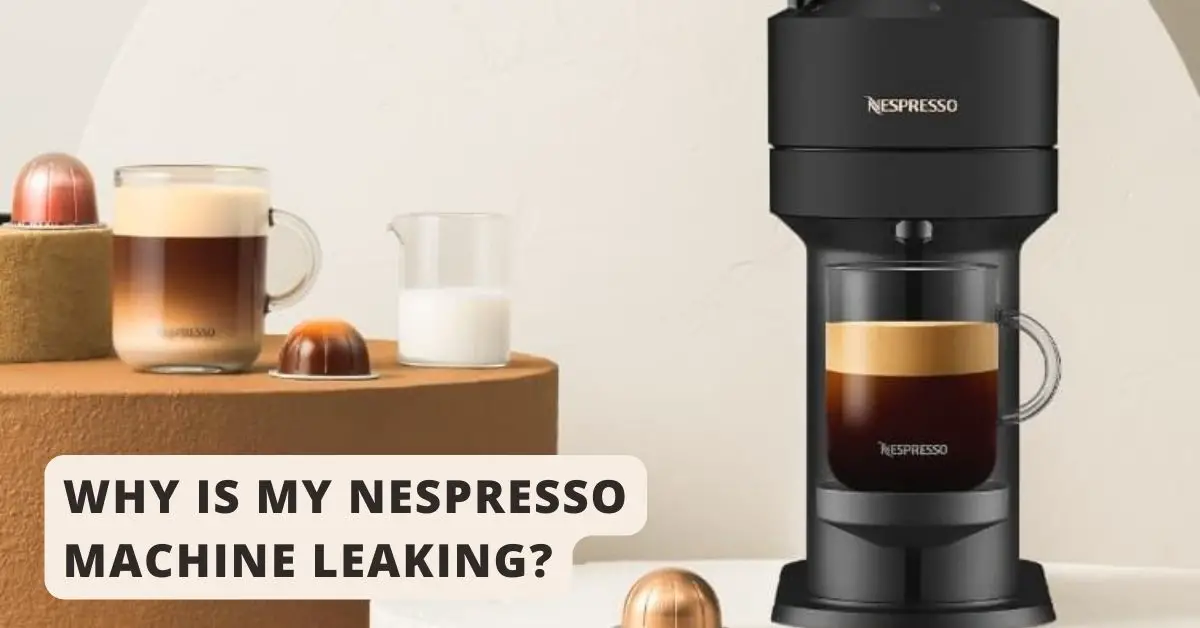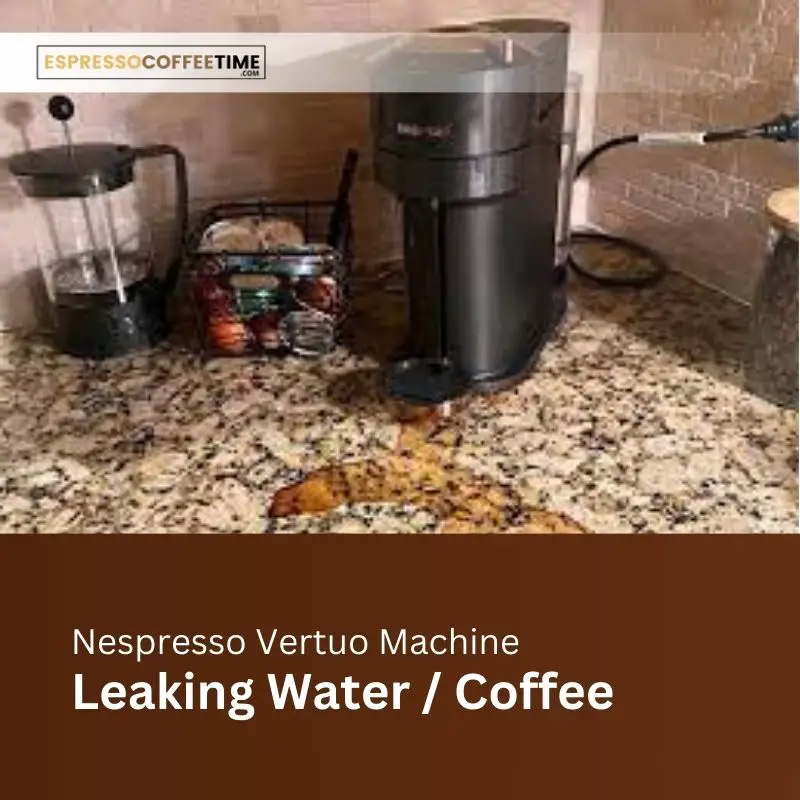Last Updated on January 30, 2024 by Timothy Byron Smith
Buying a Nespresso machine is a solid investment. However, this doesn’t mean you won’t face a few hiccups here and there. The issue may be Nespresso Machine leaking perhaps. But do not worry! Once you figure out the source, you can easily fix this issue. We can help you with that!
So, your cherished Nespresso machine is not exactly invincible. But the good thing is it will rarely trouble you, due to the quality that Nespresso guarantees. And when it does, you can quickly make things right. The question to ask yourself is ‘what is causing the issue’ and ‘how can I fix it?’
To help you go about the problem of why is my Nespresso machine leaking, here are a couple of reasons that cause a Nespresso machine to leak and how you can solve this problem.
Why is My Nespresso Machine Leaking?

There are a few reasons why your Nespresso coffee machine is leaking suddenly from different parts. The most common causes are:
- The Nespresso machine hasn’t been descaled
- Water leakage in the capsule holder system
- Water leakage in the Nespresso machine’s base
These problems can occur in any of the Nespresso machine models. So, follow this guide to understand these leakages and their causes for them. You will also find relevant solutions to quickly fix the machine and get to brewing a delicious cup of coffee.
1. Nespresso Machine hasn’t Been Descaled
The most common cause of a Nespresso machine leakage is often a lack of descaling. Nespresso itself advises users to descale their Nespresso machine every 6 months of use.
We cannot emphasize enough the importance of frequent descaling. From descaling Nespresso Vertuo to descaling Vertuo Next, Evoluo, and whatnot, there are many guides out there. If you don’t know how to learn and do it. Your machine won’t function smoothly for long if you don’t descale.
Failing to descale your Nespresso machine can cause several other issues, not just leakages. Hence, we urge you to carry out the descaling procedure in a timely manner so you can prolong your coffee machine’s life.
2. Water Leakage in the Capsule Holder System
If you are experiencing water leakage in the capsule holder system it is likely because water from the reservoir isn’t properly entering or exiting the pod. You can ascertain this issue if you notice water around the drip tray or capsule holder.
Ideally, your machine should force pressurized water through your capsule and into your coffee mug. However, due to cracks or gaps in the capsule holder system water will find other openings and leak out of them. Here are some most common causes of Water Leakage in the Capsule Holder System.
1. Clogged Nozzle:
With every brew and extraction of coffee, some of the coffee residues accumulate on the nozzle. This happens regardless of whether you brew espresso or coffee, the difference doesn’t matter. Over time this residue builds up and clogs the nozzle. It becomes an obstacle to the pressure and flow of water resulting in leakages.
One way to unclog nozzles is to take a needle or a pipe cleaner to it. However, some Nespresso machines are sensitive and this approach can end up damaging them further. If you wish to avoid the risk we suggest referring to the manual or guidebook.
2. Use of Defective Capsule:
Wait, do Nespresso pods expire or something and become defective? That’s not the kind of defect we are referring to here. Nespresso coffee machines are only compatible with pods and capsules produced by Nespresso itself. Any other capsules can potentially damage the machine.
This is because pods and capsules from other brands can vary in size. Forcing them into the capsule holder will only result in some sort of internal damage and leakages. So, try using authentic Nespresso pods to check if the problem lies there.
3. Clogged Up Capsule Holders
Did you know that the capsule holder is one of the dirtiest parts of the coffee machine?
This is because it accumulates the most coffee residue. However, it’s very easy to forget the residue being collected in the capsule holder.
One usually gets alerted to it once the machine starts malfunctioning. When this happens, the piercing plate that punctures capsules doesn’t function properly. An unpunctured capsule creates back pressure for the pressurized water and causes leakages.
To avoid this unnecessary problem, use a stainless steel wire or even an old toothbrush to scrub the dirt on the capsule holder. Use soapy water and heat it for better results.
3. Water Leakage Around Nespresso Machine’s Base
Often once you are done using the Nespresso machine you will notice the countertop to be wet around the machine’s base. The amount of water leakage can vary depending on the severity of the issue. Below are a few causes of Water Leakage Around the Nespresso Machine’s Base.
1. Damaged Water Tank
The most likely cause for this leakage is a damaged water tank. A damaged or cracked water tank will slowly leak and you’ll never know. You can check this by filling up the water tank and leaving it overnight to see if there are water puddles near the machine.
Additionally, check the connections between the water tank and the Nespresso machine. Damages to these connectors can also result in heavy leakages. If you spot these damages immediately replace the damaged water tank.
Water tanks are among some of the best Nespresso accessories and come in various styles. Just remember to purchase the one that best fits your Nespresso machine.
2. Damages in the Thermoblock or Internal Pipes
A rough usage of the machine, switching of places at the workplace, or other such things can damage internal parts. These include internal pipes, the thermoblock, and other pumps. Such damages can also be a cause of water leakage at the base of the Nespresso machine.
To assess this leakage you can run the machine with its lid open. However, this can be a dangerous task so either let an expert perform it or be super careful! Ideally, examine the water tank first. If that is intact, we suggest directly taking the machine for repairs because the problem is most likely internal.
4. Broken Rubber Seal in Your Water Tank
If you notice water under your coffee machine, the rubber seal in the water tank might be damaged. This seal prevents water from leaking when the machine isn’t making coffee. To check it, remove the water tank, fill it with water, and place it on a paper towel. If the towel gets wet, the seal is likely loose or worn out.
Contact Nespresso customer service for a repair if you have a broken rubber seal in your water tank.
How to Descale Nespresso Vertuo
What You’ll Need:
- Descaling liquid (Nespresso sachet or another brand)
- 0.5 liters of water
Instructions
Here are the key steps to descale your Nespresso machine for maintenance:
- Pour the descaling sachet into the water tank.
- Activate descaling mode as per your Nespresso machine’s manual.
- Let the machine clean itself by running the liquid through.
- Position a container under the spout.
- Refill the water reservoir with cold water.
- Flush water through the machine by pressing the power button.
- Exit descaling mode using the same button combination.
Nespresso Vertuo Leaking Coffee From Bottom
If your Nespresso Vertuo coffee maker is experiencing a coffee leakage issue from the base, it’s likely due to a faulty seal. Here’s a straightforward guide on how to resolve this problem:
- Begin by taking off the coffee maker’s bottom plate.
- Unfasten and remove the old seal located at the bottom of the machine.
- Install a fresh seal in its place.
- Securely reattach the bottom plate onto the coffee maker.
- Test the coffee maker to ensure it no longer leaks.
- This simple process should help you address the coffee leakage problem effectively.
Checking your Nespresso Cup Support or Drip Tray Overflow
To keep your Nespresso machine in top shape, it’s important to regularly check and clean the cup support and drip tray.
Cup support
The cup support should be correctly aligned and secure to avoid any coffee spills during brewing.
Drip tray
The drip tray located below the cup support, should be regularly emptied and cleaned to prevent overflow and maintain cleanliness. If you find that your machine is leaking into the drip tray, first ensure the tray is properly placed. A tray that’s not correctly positioned can cause leaks.
Check the gasket
Also check the gasket around the drip tray for wear or damage, as a damaged gasket may need to be replaced. If these measures don’t fix the leak, you might need to consider replacing the machine.
Prevention
Cleaning these parts regularly with warm, soapy water is essential for the machine’s longevity and for a great coffee experience.
What should you do if your Nespresso machine is still leaking?
If your Nespresso machine keeps leaking, don’t try to take it apart or experiment with its insides. It’s best to contact customer support for professional help. If your machine is still covered by the two-year warranty, they will typically provide free repairs, and you might even get a replacement machine while it’s being fixed. This ensures a safe and effective solution to the problem.
Frequently Asked Questions
1. Does Nespresso replace broken machines?
Yes, Nespresso may replace broken machines if they are still under warranty, and the damage is covered by their warranty terms. However, if the warranty has expired or the damage is not covered, you may need to purchase a new machine or inquire about repair options through Nespresso’s customer service.
2. Can you use dented Nespresso Pods?
If the Nespresso pods are slightly bent on the side then you can safely use them. However, if they are bent completely out of shape then refrain from using them.
3. How long is the Nespresso warranty?
Nespresso offers its customers a warranty of two years on all machines.
4. Does Nespresso warranty still apply after replacing parts?
Nespresso’s warranty status can vary; it depends on their policy. Some warranties remain valid after part replacement, while others may void if unauthorized repairs are done. Review their terms or contact customer support for clarity.
5. Can we use detergent to clear clogs?
Using detergent to clear clogs is generally not recommended, as it can leave behind residue and potentially worsen the blockage. Instead, opt for specialized unclogging products or methods designed for the specific issue to ensure effective and safe results.
Conclusion
So, if your Nespresso machine is leaking don’t fret about it. Yes, be super careful when using it because electricity and leaking water don’t mix well. But once you identify the leakage source, you can easily fix it and repair the machine.
While leakage can appear like a grave problem, it really isn’t. All you need is either descaling, replacing any broken part, or some unclogging with the Nespresso Machine, and you’ll be good to start caffeinating again!


